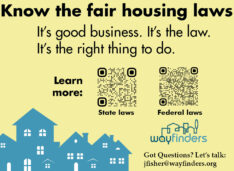Your Renters’ Winter Responsibilities
| . Posted in News - 0 Comments
By Eric Weld, MassLandlords, Inc.
Protecting your rentals from the potential destruction of cold temperatures, ice and snow and occasional high winds is a collaboration between landlords and tenants, and your renters’ winter responsibilities should be made clear before disaster strikes.

Protecting property from potential destruction of winter's snow and ice is a collaboration between landlords and tenants. CC by WikiCommons
There are several preventative steps you and your renters can take before winter sets in, or just before storms, to defend properties from extreme cold and moisture, and more essentially, to avoid slips and falls.
Renter Responsibility in Winter #1: Interior Temperature
Regardless of the type of dwelling, renters control access to the interior of their residence. With that control comes responsibility for stewarding its protection.
Primary among these interior responsibilities is taking steps to prevent pipes from freezing and bursting, a plight among the worst home disasters. That means keeping the heat programmed to a minimum setting that assures a suitable distribution of heat throughout the unit at all hours.
The minimum thermostat setting will depend on how well sealed and insulated your rentals and building are. If you have an older building with leaky windows, and that hasn’t had updated insulation or moisture sealing treatment, the thermostats in your rentals may need to remain higher in order to offset the heat lost through the walls, windows and attic. But if it’s a newer building or if you’ve had cellulose insulation blown into your building’s walls, had attics and any crawl spaces sealed, and replaced windows, the rental units can maintain a cooler temperature without risk of freezing.
(Contact Mass Save for information on free energy assessments, grants and no-interest loans for sustainability upgrades such as insulation, sealing and replacement windows.)
Setting the Thermostat
Thermostats are installed on interior walls, so keep in mind that the temperature reading on a thermostat may display higher than in spaces near doors and windows, and exterior walls. There are hundreds of Wi-Fi temperature sensors available that can sit in a closet, under a sink, next to a door or in a bedroom, and monitor the interior temperature. Some can even be set to issue alerts if the temperature drops below a programmed minimum.
Tenants can also help distribute heat to vulnerable areas by leaving open cabinet doors under the kitchen sink to allow warm air to circulate around plumbing there; leaving the basement door ajar to lend warm air to pipes below ground; and maybe cracking the attic access if there are pipes running there as well.
Keep in touch with tenants in winter so you’re aware of any cold or drafty areas in the rental that you may need to pay attention to.
Open Taps
When outdoor temperatures dip below 20 degrees, tenants may need to leave taps open. Allowing a slow drip of water from the faucet can relieve the pressure and avoid burst pipes, even if water freezes.
If tenants plan to leave home for a few days or longer, they should open the taps slightly. They should also inform you as their landlord so you can be aware that your property is temporarily untended during potentially frigid weather and any storms.
Renter Responsibility in Winter #2: Spreading salt and sand to avoid slips and falls
Among the most important pre-storm measures you can take at your rentals is spreading sand or salt on walkways, steps, driveways and any other exterior places tenants may be walking. (Use of salt on public walkways may be prohibited in some communities. A variety of alternative de-icing products are available.)
Safe egress is the legal responsibility of the landlord, unless egress is located in a place exclusively accessed by the tenant (e.g., an enclosed, screened porch that might collect ice or blowing snow inside).
Spreading salt or sand on walkways before storms should be a routinized, clear and compensated role for a landlord or team member. This is a vital task to be done regularly before every storm for which the National Weather Service issues an icing or freezing warning. The risk of slips and falls on ice is too high to take a chance on this step.
After the Storm
In most cases in Massachusetts, snow and ice removal are landlords’ responsibilities, and penalties for neglecting snow and ice removal from public walkways falls on property owners, not renters. However, according to M.G.L. Ch. 40, §§ 2,3,4, municipalities may write bylaws specific to snow and ice removal that supersede the state law.
For legal compliance and other reasons, most landlords may prefer to manage the clearing of snow and ice on their properties. To leave a potentially hazardous situation in the control of renters might be asking for possible trouble later on in the form of misunderstanding, neglect or, worse, litigation if an injury takes place on rental property.
In the case of some single-family rentals, it may be part of the lease agreement that tenants will clear snow and ice from the property’s walkways and parking areas and from public walkways near the home. Landlords might reiterate these responsibilities at the beginning of the season, and certainly if that duty is neglected.
Renter Responsibility in Winter #3: Clearing Items from the Yard
Renters are responsible for removing and safely storing their belongings – garden hoses, furniture and toys in the yard, potted plants on the deck – before winter hits.
It’s especially important for renters to make sure items are removed from areas that will be snow blown such as walkways and driveways. Toys, stray scarves and mittens, trash and other items can wreak havoc on snowblowers if they become snagged or clogged. Worse, they can pose a grave danger if handled improperly.
Renters may also be responsible for removing or covering air conditioner units. And in some cases, such as single-family rentals with yards, tenants may be responsible for covering outdoor spigots with insulating material.
Renter Responsibility in Winter #4: Mice
It should be made clear to renters that they are responsible for informing landlords any time they see signs of the ubiquitous winter pests: mice (and, less frequently, rats).
Mice, the most common winter home infiltrator in New England, can get out of hand in short order if unmanaged. They breed quickly so that a couple visitors can fast become an infestation. Mice, which can squeeze their bodies through gaps and holes the size of a dime, can carry disease, larvae and unsanitary dirt, dust and oils into homes. And if left unguarded, mice and rats might chew on wires, fabrics and plastic in order to procure nesting materials, and raid food containers.
Renters should know to notify their landlords the minute they see the indicative mouse droppings around food areas, or if they hear or see the nighttime visitors.
Renter Responsibility in Winter #5: Emergency Plan
Finally, in case of disasters such as fires, burst pipes or furnace malfunction, renters are the first line of defense and are responsible for contacting emergency services. Landlords should make sure their tenants have a list of local emergency contacts readily available.
For renters’ safety as well, an emergency plan should be discussed at lease signing. If renters need to escape the unit for any reason, or quickly turn off the water main, having discussed it before the moment of disaster could save lives and properties.




